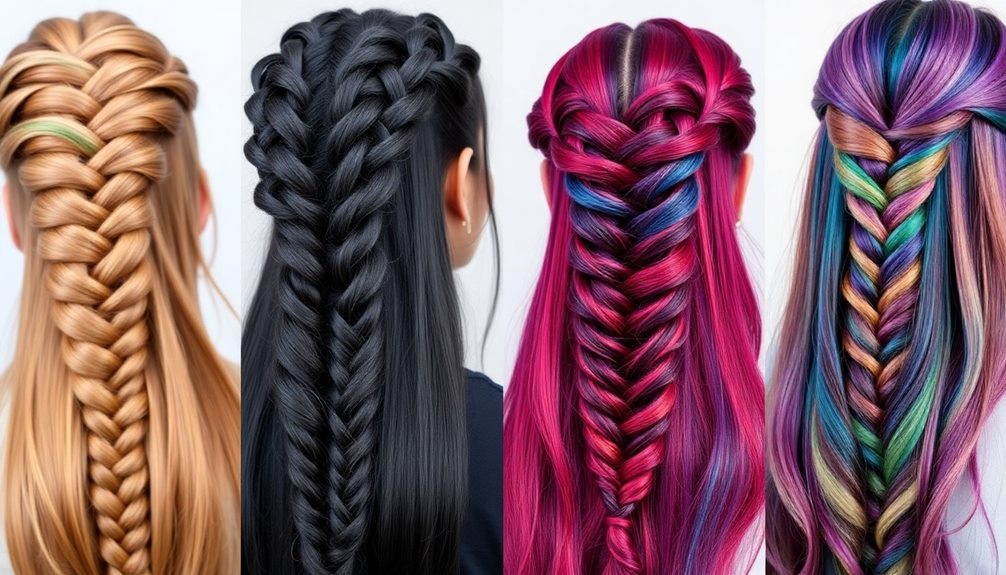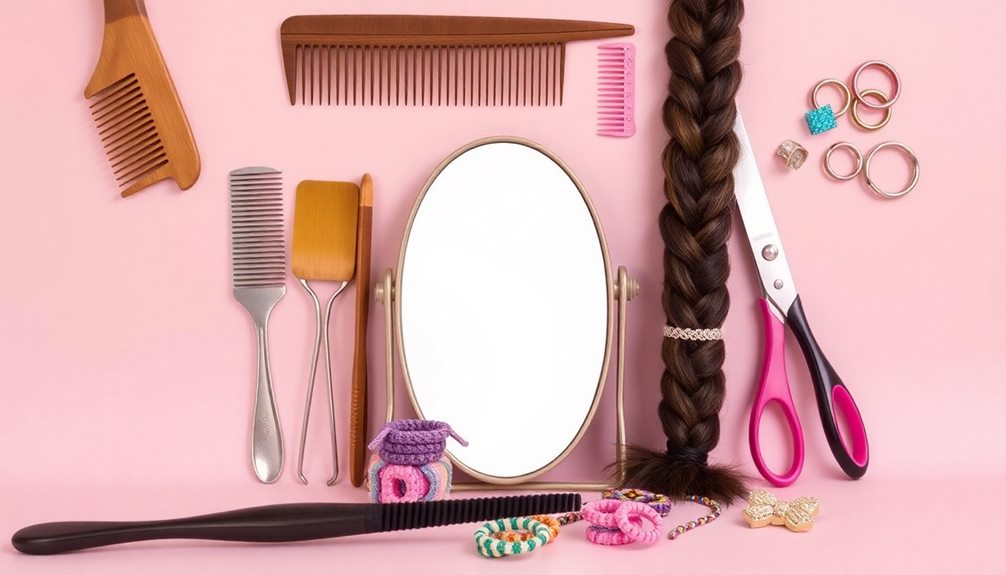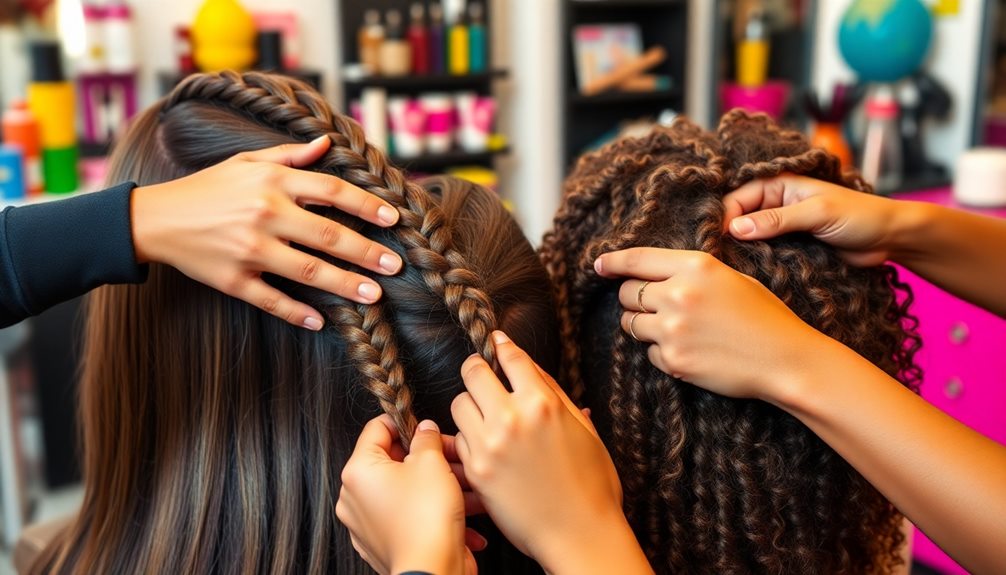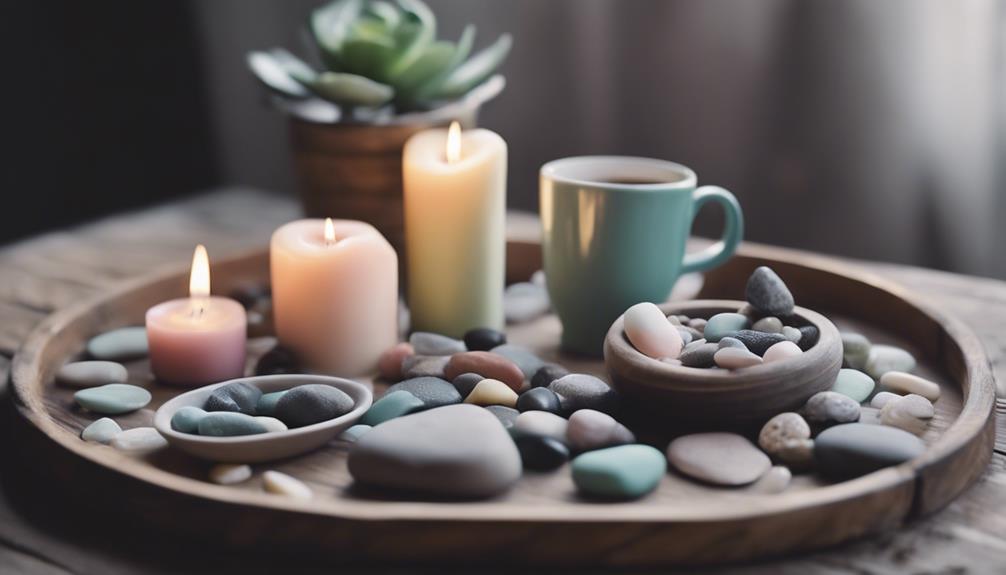Advanced braiding techniques can elevate your hairstyling skills, no matter your hair type. Start by mastering the three-strand braid, then move on to styles like the fishtail, Dutch, or waterfall braid. Use essential tools like a comb, clips, and texturizing spray to make the process smoother. Don't forget to contemplate braid extensions for added volume and length! Maintain your braids with light oils and a silk scarf for protection. With practice and the right techniques, you'll create stunning looks. There's so much more to explore in the world of braiding, so keep going to reveal more secrets!
Key Takeaways
- Master the fishtail braid by alternating small pieces from two sections for a textured, intricate look suitable for various hair types.
- Experiment with the Dutch braid, which braids under instead of over, creating a 3D effect that works well with thicker hair.
- Utilize braid extensions to add volume and length, ensuring a color and texture match for a seamless appearance.
- Incorporate unique sectioning techniques, like waterfall braids, to create visually stunning patterns that enhance your overall style.
- Maintain braids with regular moisturization and a silk pillowcase to reduce friction, promoting longevity and a polished look.
Overview of Braiding Techniques

Understanding the fundamentals of braiding techniques is crucial for anyone looking to elevate their hairstyling skills. Mastering the three-strand braid is your starting point, as it lays the groundwork for more advanced styles like the fishtail braid, Dutch braid, and waterfall braid.
Each of these techniques involves a unique way of sectioning your hair and manipulating strands, enabling you to create intricate patterns and textures that appeal to various hair types. These methods not only highlight your creativity but also cater to different individual preferences, ensuring a personalized touch for each look. With the influence of Japanese hair styling breakthroughs, these techniques have evolved to emphasize precision, balance, and harmony, elevating hair artistry to new heights. By blending traditional approaches with modern innovations, you can achieve hairstyles that are both timeless and trend-forward.
As you immerse yourself in advanced braiding, you'll find that working with multiple strands can enhance your styles considerably. Incorporating braid extensions can add volume and length, allowing for even more creativity and drama in your hairstyles. Box braids are a fantastic example of this, providing a bold look that's both stylish and practical.
To achieve the best results, practice is essential. The more you work on these braiding techniques, the more proficient you'll become, enhancing the aesthetics of your braids.
Essential Tools for Braiding

To create stunning braids, having the right tools at your fingertips is fundamental. Start with a good comb and brush to detangle your hair thoroughly. This guarantees you have smooth sections, which is imperative for achieving clean and polished braids.
Once your hair is tangle-free, use clips to secure sections as you work, preventing any hair from getting mixed up or tangled during the process. Hair ties are another must-have, as they're critical for securing your finished braids and keeping sections organized while you braid.
For added texture and grip, consider using a texturizing spray before you begin. This can enhance volume and make it easier to manage your hair. To achieve a polished look, don't skip out on mousse or hair oil. These products not only add hydration but also provide shine, improving the overall appearance of both natural hair and any extensions you might use.
With these fundamental tools and products, you'll elevate your braiding skills and create beautiful styles that stand out.
Step-by-Step Braiding Styles

When it comes to mastering braiding styles, following a clear step-by-step approach can make all the difference. Start by selecting the appropriate section size based on the desired braid thickness. Larger sections create chunkier braids, while smaller sections yield finer details. Use a rat tail comb to create clean and uniform sections, enhancing the overall appearance of the braid.
Here's a quick reference table for three common braiding styles:
| Braid Type | Steps to Create | Tips for Success |
|---|---|---|
| Three Strand Braid | 1. Section hair into three parts. | Secure the ends with a small elastic. |
| Fishtail Braid | 1. Divide hair into two sections. | Alternate adding small pieces. |
| Dutch Braid | 1. Section hair into three parts. | Braid under for a 3D effect. |
Tips for Maintaining Braids

After perfecting your braiding techniques, maintaining those styles is key to keeping your hair healthy and your braids looking fresh. Here are some essential tips to help you care for your braids:
- Moisturize your scalp and braids regularly with light oils or leave-in conditioners to prevent dryness and promote hair health.
- Use a silk scarf or pillowcase while sleeping to reduce friction and frizz, which keeps your braids looking neat longer.
- Wash your braids every few weeks with a sulfate-free shampoo to remove buildup without damaging your extensions or natural hair.
- Avoid excessive tension at the roots during installation to prevent scalp irritation and potential hair loss, especially with tight styles.
- Reapply clips or ties to any loose or slipping braids to maintain a polished appearance.
Choosing the Right Extensions

Selecting the right extensions can make all the difference in achieving a flawless braid. First, focus on color match and texture. You'll want your extensions to blend seamlessly with your natural hair for a more authentic appearance. Testing various shades in natural light can help you find the perfect match and add dimension to your look.
Next, consider the length and weight of the extensions. Lighter extensions are more comfortable for all-day wear, while longer ones can create dramatic volume and length. High-quality, 100% human hair extensions are your best bet, as they provide greater softness, manageability, and styling versatility compared to synthetic options.
When exploring different extensions, think about how they'll work with your desired braiding techniques. Some styles may require thicker, heavier extensions, while others might benefit from lighter options.
Lastly, don't hesitate to seek professional recommendations tailored to your hair type and desired style. An expert's insight can greatly enhance the overall outcome of your braids, ensuring you achieve the look you want with ease.
Frequently Asked Questions
What Is the Hardest Braid to Do?
You'll find the five-strand braid to be the hardest to master. It demands precise sectioning and coordination of multiple strands, making it a challenging yet rewarding skill to develop as you progress in braiding.
How Many Braiding Techniques Are There?
Did you know there are over 20 distinct braiding techniques? You'll discover a variety of styles, from basic to intricate, each offering unique creativity and versatility, perfect for expressing your personal flair in hairstyling.
Can All Hair Types Get Braids?
Absolutely, you can braid all hair types! Whether your hair's straight, wavy, curly, or coily, just remember to adjust your techniques. Focus on moisture and gentle handling to keep your braids looking fantastic without damage.
How to Do Dutch Infinity Braid?
"Practice makes perfect." To create a Dutch infinity braid, section your hair into three equal parts. Braid under, adding hair as you go. Finish with a standard braid, securing it for that stunning infinity look.
Conclusion
Now that you've explored advanced braiding techniques, you're ready to transform your hair game. Imagine walking into a room, turning heads with intricate styles that showcase your creativity. But wait—what if you could take it even further? With the right extensions and a few secret tricks, you can elevate your braids to the next level. Are you ready to release your inner stylist and leave everyone wondering how you did it? The possibilities are endless!









